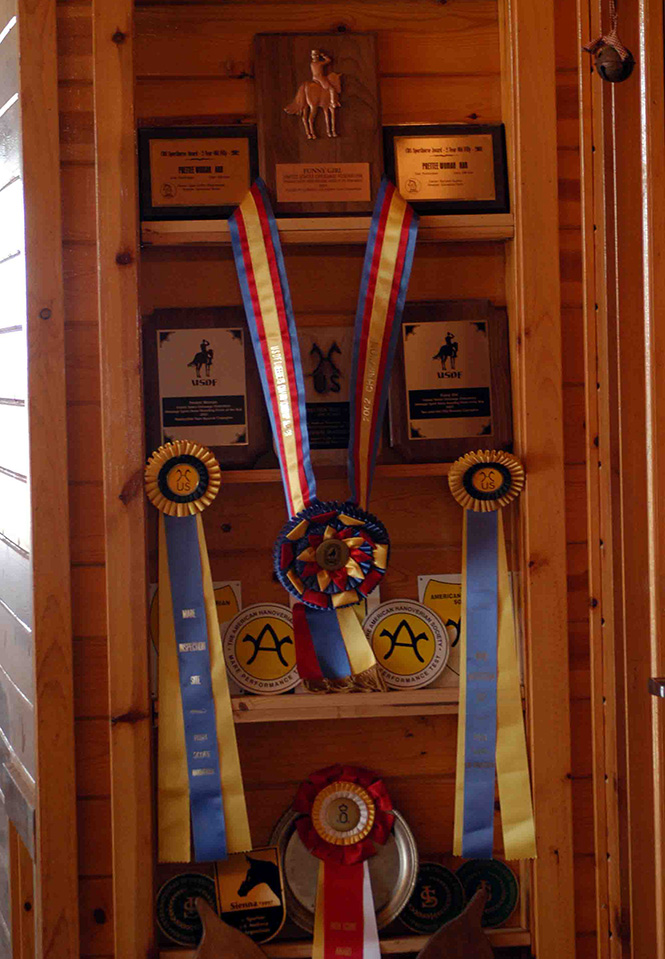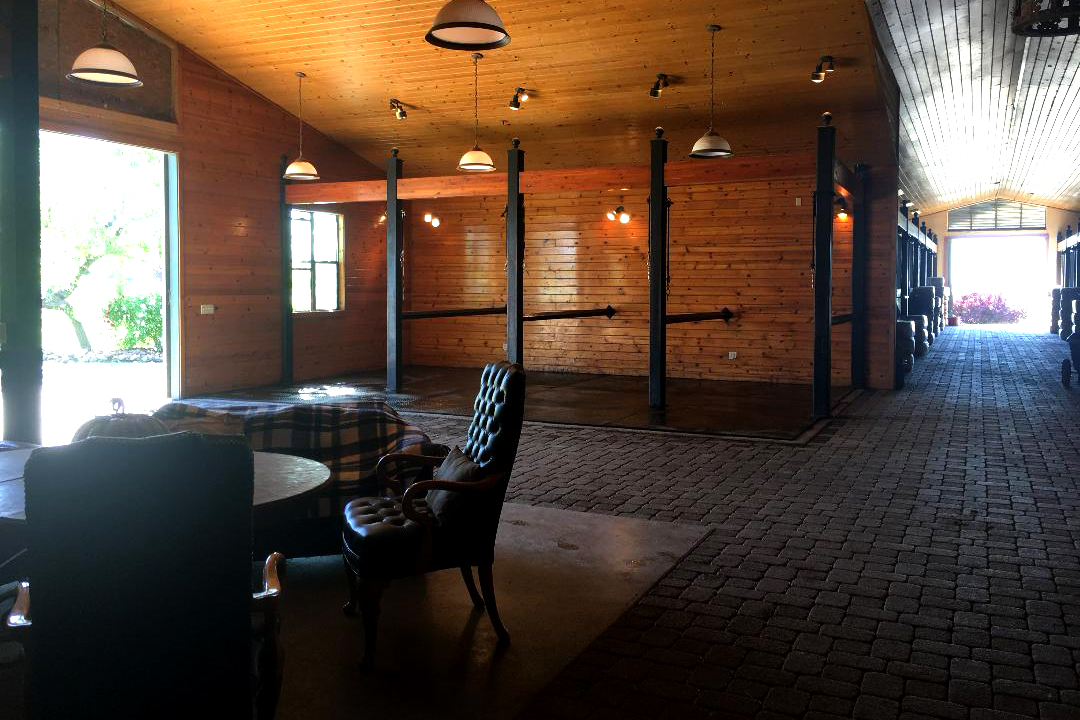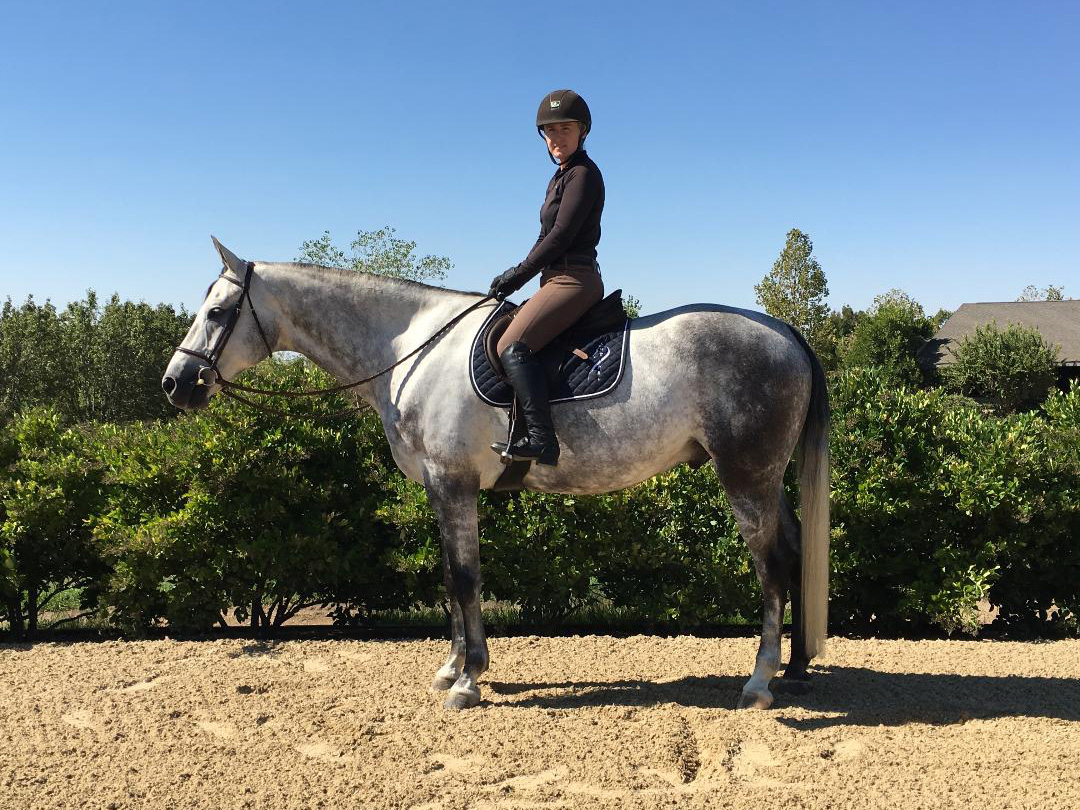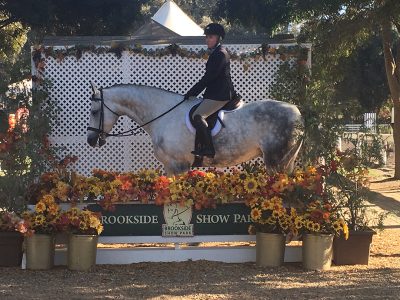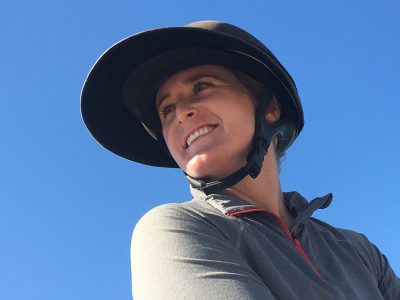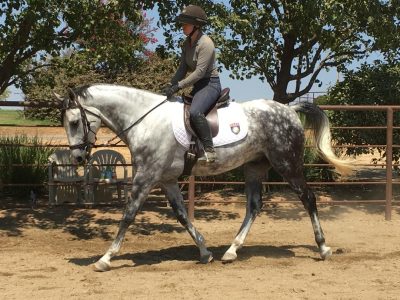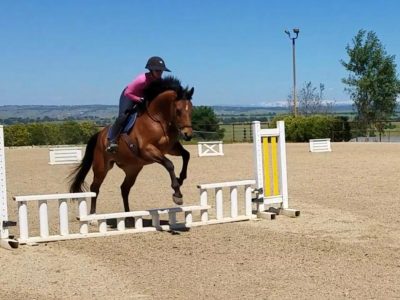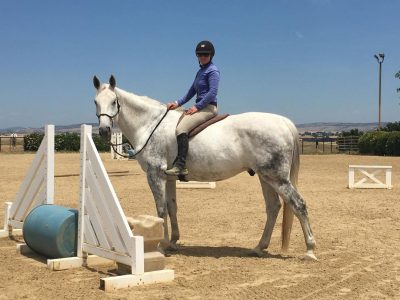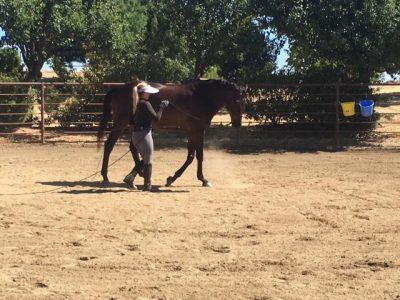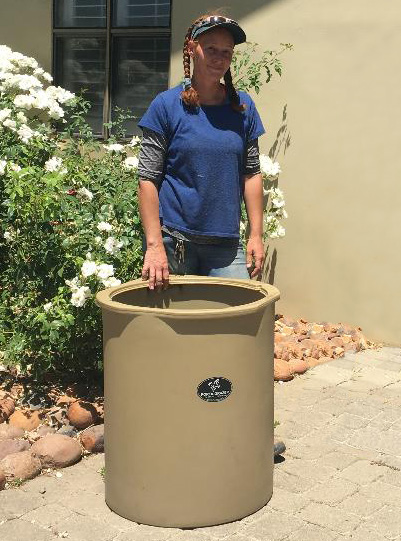Offering European Quality for the American Market
Silverhorne is located on 80 rolling acres in the foothills of the Sierra Nevada Mountain Range of Northern California. Originally operated exclusively as a show/training barn as early as 1989, the facility was established in 1999 at its present location. The focus is exclusively on peer training through resident clinics, raising, starting and showing offspring for sale by its resident stallion and select outside studs. Silverhorne began its breeding program with significant imported German jumper bloodlines and purchased Sir Caletto from Paul Schockemohle when it became apparent the market place would embrace the decision. Sir Caletto daughters have also proven to be excellent broodmares and Silverhorne continues to expand using outside stallions to continue its program. We invite you to review our selection of offspring and make time for a sales visit.
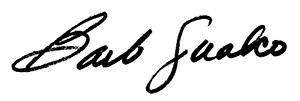
We are producing good-minded horses who are encouraged to think and be self-supportive, so that when they leave this program they are also prepared to succeed as a result of the educational advantages our horse development program has provided them.
Barbara Gualco, Silverhorne Sporthorse
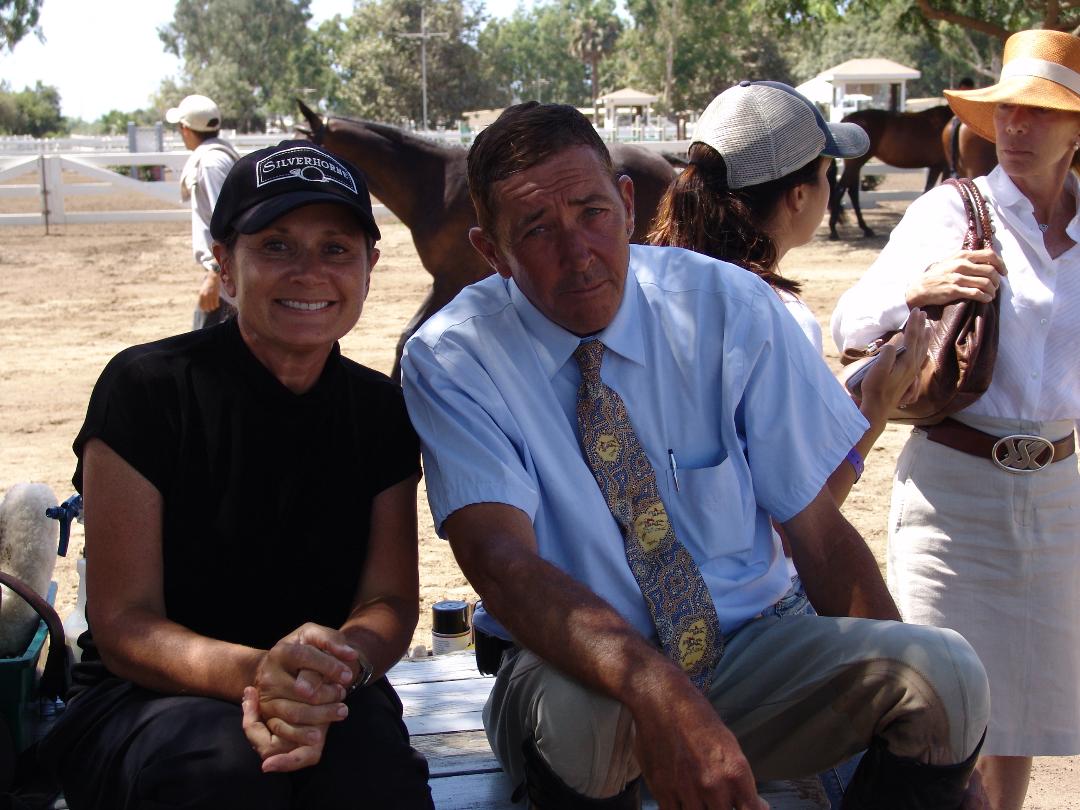
Barb pictured with Champion Grand Prix and Hunter Hall of Fame member, Hap Hansen. |
Barbara Dillon Gualco
Silverhorne Founder
Having followed her veterinarian father, Ben Dillon around show and training barns, jumpers, reiners, penners, she was always completely seduced by the horse and the people she admired who sat on them. She rode through her early teens and then returned to riding and jumping in her 20’s. Training interest began with buying off the track Thoroughbreds like many did for retraining for the show jumping market. She partnered with two young riders and started G & G Hunters and Jumpers. One really great mare by Kennedy Road xx was trained up to preliminary level and did well on the A Circuit and with her jump and rideability she bested a large field of warmblood mares to make Champion of conformation and under saddle test with scores that impressed the AHS inspection committee that year at Glenwood Farms. From there she looked at attaining imported mares from Germany to train, show and gain entry into the AHS registry and began to breed for raising and sales.
Barb and husband Jack built Silverhorne’s present facility and moved horse and clients on site in 1999, having started the breeding program in 1997. Early on a respectable broodmare band was developed by German standards with approved mares, both domestic and imported, mostly Hanoverians but also Oldenburg and Thoroughbred mares. While working to maintain balance between owning a show and training barn and starting a breeding program, it became apparent that the program would have to find a resident stallion and Sir Caletto was imported from the Oldenburg region from Paul Schockemohle yard in 2002. Cutting her teeth on inspections at Glenwood led to her hosting AHS inspections at Silverhorne in 2003, ’04 ’05, ’06, ’07, ’08, ’09, ’11 and 2013.
The breeding program included a significant mix of both jumping and dressage bloodlines as Silverhorne had a dual discipline training program at the time. The program still remains true to its roots in breeding good minded horses who are athletic and can serve well as both jumping, mostly the hunter ring, as well as eventing and dressage.
IN HER OWN WORDS… Q & A WITH BARB
Why are you still in the business of breeding and training 20+ years later?
I enjoy all of it most of the time and some of it all the time. The technical aspects of training, movement, keeping them in good health and treating them right, getting them to the show ring smoothly and without incident..that’s a success in and of itself.
How does one do that?
Handling, ground work that establishes boundaries, trailer training, farrier and vet prep time, field trips and more field trips, structured under saddle time, farm walks, both from the ground and under saddle. Lots of walking, teaching lateral.
How do you know this?
Well I didn’t invent the style of training we use now…Ray Hunt and the Dorrance brothers did that, and other successful practitioners long before us, we just put the puzzle pieces together and burnished it with our own hand. The patience these horsemen showed their horses and showed other people are methods that pay off every day for us.
Read More
Who introduced you to this style of training you seem to think works?
A young woman who I knew from a large Hanoverian breeding farm.. She said I looked and handled like I knew there was an easier way and from there I found my way to professional colt starters who shared a vision of kindness and leadership our horses responded well to.
What did they do?
Colt started with ample amounts of ground work—they showed me you could back a horse and have him not only accept you but embrace you sitting on him without objecting and without chasing him or lunging him to tire him to achieve that step.
What impresses you most in the horse world?
Watching how others get their horses successfully to the show ring and my discovery of the best new thing for providing the grazing experience to penned and stalled horses, the Portagrazer.
What is that?
It’s a feeder designed for proper feeding no matter where the horse is located, in a stall, at a show, outside in his pen. Keeps the digestive tract calm by allowing him to access actual bites of feed that mimic field grazing, the head is down and digestive juices are appeased whenever he has the signal from his digestive tract that it’s time to eat. They make a huge difference to the horse and how he is to be around with steady access to feed throughout the day.
What attracted you to the profession?
I thought I could contribute something in the way of responsible training. Like many I rode as a kid and then came back to it as an adult. The mysterious ways of training fascinated and yet confounded me. As it did every other amateur rider at the barn where I rode—we jumped fences with no understanding of impulsion nor how the horse felt about being forced over a course. Everyone seemed to rely on speed over good sense. There was nothing uniform about it or consistent except trying to wear out horses so they wouldn’t object. I thought there must be a better way and started to look at alternatives.
What happened?
The light bulb over the head moment was discovering professional colt starters…They landed someplace in between sending horses off to a cowboy and just slapping a saddle on and lunging some poor jockey in the round pen and hoping it all worked out.
So this is the way you break horses?
I have not used the term “breaking” in a 15 years.
No but really, why do you think you were so attracted to the profession?
I grew up with an equine DVM father who graduated from UC Davis and who grew up on a cattle ranch in Los Angeles County. He was a cattlemen all the way and went to vet school so he could stay in the field. And ran around show barns run by Gene Lewis, Don Dodge, Bobby Ingersoll, Barbara Worth Oakford, Red Lott, Dick Diller, Willie Mendenhall, Betty Green, Barb Hatch and Leonard Dunn—jumping horses, cutting horses and Tennessee Walkers were all over Northern California and I’d go after school every day with dad to one of those barns. Horses and trophies and ribbons oh my.
Why did you start breeding?
I saw Peter Breakwell ride a warmblood around a Grand Prix course at Rancho Murieta and was completely sold. It looked like a hunter round. Peter has no idea the influence he had on me. And the DVM father asked why I was training horses to jump that were bred to run between two white fences. That resonated.
What’s the hardest thing you’ve had to accept in the industry?
That riders and trainers think intimidation tactics create a rideable or safe or sane riding partner for an amateur. Finding people who, like me, want to work with and train horses and not bully and push them around. Not treat them like robots or do it without any sense of decency where the animal is concerned. We know better and we can now do better.
What’s the most important thing in training in your view?
Becoming aware—discovering there were people like Ray Hunt, Tom and Bill Dorance and yes even Buck Brannaman. I know it sounds so cliché but these people understood and present day practitioners understand horses. There are tons of them on the West Coast… When I hooked up with the Jessops it was like a bucket of cold water in a good way. We were starting and training all wrong. Recognize that they are the primary athlete, they are bigger and they have an opinion you need to respect.
What is your greatest achievement?
I hope it’s yet to come. In spite of that, two things; developing the style of starting and training we now enjoy it has been a 15-year journey and the forerunner to that was studying movement of the horse—spending time in Germany and watching how others excel and then trying to translate it to the American culture. Hanging out in the warmup ring, watching mares get inspected for conformation and movement, spending time in Germany and studying pedigrees—I still have those stallion pedigree books which help me sort out the plethora of new stallions coming onto the scene. Roots on good blood lines show up again and again. The flavor of the month stallions, those will always wax and wane.
Figuring out how warmblood inspections work, the scoring and how to evaluate and score mares for breeding and how to best prepare a mare for her performance test. It sounds trite but people get defensive about their favorite mare and feel every mare is right for breeding. I’ve seen some ugly behavior at the inspections. It’s subjective but it has parameters and standards that have to be applied and you cannot take it personally. No one explains anything until you find a good resource or you attend a decade’s worth of shows and inspections and you should already have an idea of what good movement is and apply what you know. Suspension, elasticity, conformation, study it and then proceed with caution.
You’ve hosted 8 AHS inspections and attended other farm inspections. What happens?
It’s a great learning curve for the uninitiated. I lucked out and took a very well prepared open jumper mare who was champion at her inspection and mare performance test. Little did I realize how hard it is to get those scores.
Were you a mare owner first or stallion owner?
Mare owner. Which helped when we imported the stallion as far as breeding organization goes.
Have you enjoyed owning a show and breeding stallion?
Yes. Sir Caletto has been a dream to work with and share with American breeders…good character and great semen helped. The babies are good minded and have lovely conformation with jump.
How do people go about selecting a stallion for breeding in your opinion?
Well sometimes people research the heck out of a stallion and then choose him for the simplest reason. Others are totally knowledgeable and experienced and they’ve made the choice by the time they contact you. Or they have a chance to buy a stallion that does not get snagged by the State Stud or a wealthy buyer at the keurings. Or they see a stallion at a show, jumping a fence, he’s not approved in any registry or he got a 90 on his 100 day test in Germany and now he’s the flavor of the month. Building a stallion’s reputation takes years. I subscribed to the German Hanoverian Verband, as breeders are obligated to follow their licensing standards and rules. American breeders and trainers who have show mares are not always impressed with that process or don’t see a reason for it.
What’s the best thing that’s happened on the show end of things for you?
Having horses back and showing. I took a 10 year break from showing horses because I badly wanted to retool the training program to better address the mind as well as the physical aspects of the offspring I bred. That has huge and it took a decade accomplish. I am fortunate now to have great people I train with and that makes all the difference. I am excited again and optimistic. And auto-fill on show entry forms.
What initially attracted you to the profession?
Father is a large animal veterinarian. I grew up running around Don Dodge, Barbara Worth Oakford, Barb Hatch, Betty Green, Bobby Ingersoll, Red Lott, Dick Deller, and Willie Mendenhall’s barns. It was a kid’s dream.
What is your greatest joy related to the horses?
That I see people wanting more for them, to have them happy and not be treated like slaves, that colt starting is become a truly recognized profession. It’s always been that people would say I sent my horse to a cowboy but never seemed to understand how that changed their horse. People are more savvy now.
What frustrates you the most?
That I didn’t see earlier on that the US breeding and show industry will never be like Germany or Holland or France or any European horse producing country. The concentration of horses in those countries and the way we are spread out is a challenge. Clients on the east coast can easily hop a plane to Europe and vacation at the same time to shop. I am all about that but American breeders have to show off their horses better. Shopping time is pretty ram and jam at times and it hurts to see your horses dismissed if they can’t do something…I’d like to see riders be able to work things out more successfully.
Why are you still at it?
I have enough in the rear view mirror to say we are in a good place.
Who do you thank for where you are today?
Too many to thank. I should make a list. Right now at this minute it’s the people whose picture and name show up on this website…they are the best.
Home Team
KELLY TAYLOR
Head Rider & Horse Development Specialist
Kelly Taylor’s life-long passion for developing lasting equine partnerships, coupled with a finely honed ability to develop an educated horse and an unwavering loyalty to the mind and physical welfare of the horse, all work together to help her create prepared and confident competition partners. Her pleasant, straight ahead manner makes her comments as a clinician on horse development methods relatable to her peers and clients. She is Silverhorne’s head rider and has moved into the ranks of horse development specialist, competing on the A circuit in California. Kelly has shown horses over fences since 1997.
Read Full Bio
Ms. Taylor’s life-long passion and empathy for her horses have allowed her to develop strong equine partnerships with Silverhorne’s horses. As head rider, having joined the training and show barn in July of 2015, she focuses exclusively on the development of young horses from the established breeding program. Background coupled with experience in show and training barns under mentorships with Amy Bissell Hess, Gry McFarland, Lane Clark, Mickey Hayden, and Jim Hagman’s Orange County based Elvenstar made her an excellent fit with Silverhorne’s focus on horse development- from raising, starting, developing to show ring.
Kelly has furthered her professional development with a well-conceived and mentored ground work program, an innate ability to read a horse and understand how important it is to break it down so he fully understands and walks away from each training session feeling like he’s done things right. She studies and applies training techniques brought to her by peer professional training sessions. She has learned the art of how best to achieve reciprocal communication with her equine partners. Preparation of each horse and attending to the needs of the horse matched very well with the focus of the Silverhorne program; show the horse every consideration, develop good and clear boundaries, break down each step in the training process and make the horse right each step of the way. Kelly’s ability to prepare the well-bred European bloodlines in a way that American clients can succeed with her horses is the hallmark of her and the Silverhorne Horse Development Program.
Growing up on a ranch near Fresno, CA, horses have been a part of Kelly’s life for 25 years. She was introduced to riding at an early age and developed her love for them through means afforded her by her parents: riding to school, showing in all disciplines, learning to ride and jump bareback, and swimming her horses in the Kings river. Growing up with these experiences, she developed a unique and deeply personal relationship her horses where communication came honestly and naturally. Competing began at the age of 5 and while she has experience in many disciplines, her heart remains loyal to show jumping.
A three-year stint as Captain of the UC Irvine Equestrian team, she was the top IHSA rider in the Western Region of the US in 2013. That same year she was awarded the UC Irvine Female Student Club Sport Athlete of the Year and represented the US at a collegiate competition in Europe. At 19 she turned professional.
A graduate of UC Irvine with a B.A. degree in Social Ecology, her focused major has helped in the psychological aspects of successful teaching, learning, and relationships. This combined with heightened horsemanship skills and her ever-growing love for horses has significantly improved her relationships with horses under her care and leadership. Kelly believes that a combination of patience, understanding, communication, and fun create the best learning environment for the horse.
I have come to appreciate that we have to teach the horse with positive reinforcement, patience, and understanding.
Kelly Taylor, Horse Development Specialist
Jennifer Rae O’Connor Ondechek
Farm Management
Jen is our jack of all trades—she can handle and ground work, warm up and groom and cares deeply about the welfare of our horses! She manages the entire farm shoe and trim program with our cherished farrier, deworms and vaccinates. She’s got a heavy background in farm management with a focus on equine health and welfare. She started working with Anglo-Arabs early on and her life-style and love of horses ran the gambit from their look and yes, even the fragrance associated with the horses! She’s tried everything from trail, gymkhana, jumping and eventing as well as dressage with her Quarter/Arabian cross whom she bred to further her future with the horses. Her career spans two decades’ worth of focus on farms, boarding and training, warmblood inspections and working with Friesians, Andalusians and now Hanoverians at Silverhorne.
One stand out position for Jen was her position at Garrison Forrest School in Maryland where she managed horse care for the young ladies riding school and polo team. Upon moving to California she managed and trailed a client’s quarter horses in the Granite Bay area.
Joining Silverhorne in 2016 she has taken over duties of handling and grooming that go well beyond the norm—she has immersed herself in Silverhorne’s groundwork program and works daily to expand her handling and ground skills, moving into assisting with the A list of horse ground work preparation for under saddle work. She travels with the team to set up and groom the horses. She knows their little idiosyncratic behaviors and likes and dislikes. She sets jump courses with Kelly and Barb, can drag a mean arena and provides support to other employees. She is a highly valued team member who continues to excel in her role at Silverhorne.



